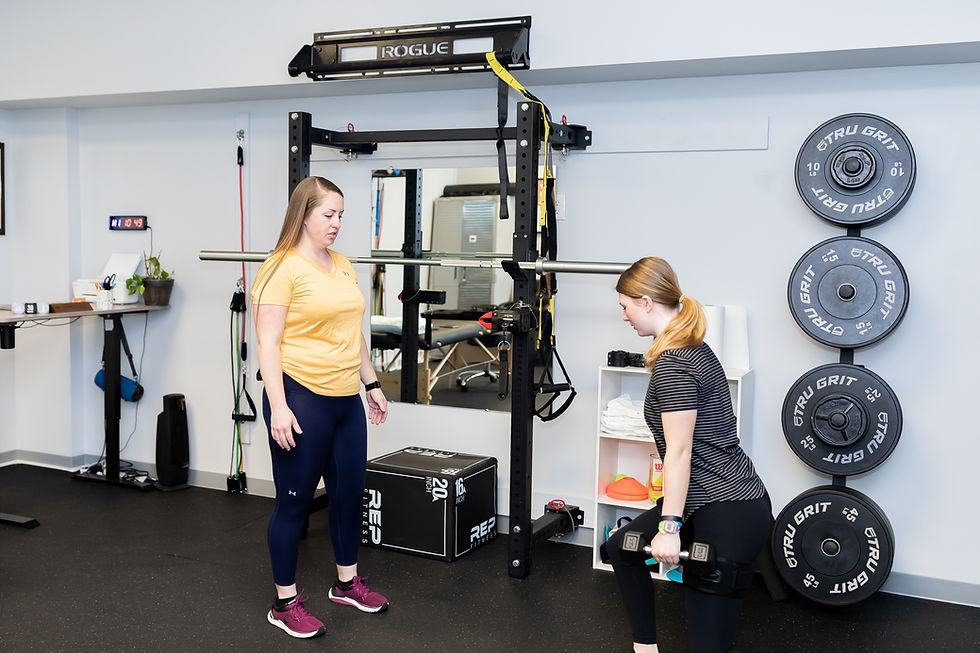7 Keys to a Successful Return to Sport After an ACL Reconstruction
- Dr. Sieara Hinshaw

- Apr 21, 2024
- 4 min read
ACL reconstruction (ACLR) surgeries can be the best option for certain candidates, but they are followed by a lengthy rehabilitation process. Once rehabilitation is completed and an athlete returns to their sport, there is then the concern of reinjuring the ACL. Research has been looking into what risk factors increase the likelihood of retearing the repaired ligament.
Literature has discovered a higher rate of ACL injury after an ACLR than previously thought. One study found that 6% of ACLR’s had an ACL injury within 2 years of surgery (half were graft failures and half were in the other knee). Another longer term study found at 5, 10, and 15 years the second ACL injury rates were at 12%, 27%, and 31% respectively. A last systematic review with 5 year outcomes found a 17.2% second injury rate. Interestingly, more of those injuries were on the opposite, non-surgical knee than the surgical knee. While we have a pretty wide range of reinjury rates (6%-31%), it is definitely important enough to have a discussion as to what the risk factors are that cause this and how to most successfully return to sport after an ACLR.
Several risk factors that contribute to reinjuring a surgically reconstructed ACL are:
1. Premature Return to Sport: Returning to sports too soon before the graft has fully healed increases the risk of reinjury. There has been consensus that waiting at least 9 months for full return to sport is recommended. This may vary depending on the patient but returning to sport earlier than 9 months post-op does increase the risk of reinjury.
2. Younger Patients: Younger patients are at a higher risk for graft failure.
3. Use of allograft tissue: Allografts are taken from cadavers' vs autografts which are taken from the patient’s own body. Research consistently supports the use of autografts when able as they are more durable and cost-effective.
4. Poor Rehabilitation Compliance: Inadequate adherence to the rehabilitation program can increase the risk of reinjury. This includes early discharge from physical therapy. I see many patients who either had chosen to discontinue care at 3-4 months post-op or were “cleared” by their physical therapists early. This is a poor decision as there is no way to physically rebuild your body in that amount of time and be prepared for the demands of higher-level physical activities.
5. Muscle Weakness and Imbalances: Weakness in the muscles surrounding the knee, particularly the quadriceps and hamstrings, can lead to instability and increase the risk of reinjury. This is a reason why high-quality return to sport testing is necessary so that patients are not returning to activity with ex. only 80% of the strength of their non-surgical side.
6. Biomechanical Factors: Issues such as abnormal movement patterns, poor neuromuscular control, and faulty landing mechanics can place excessive stress on the ACL graft, increasing the likelihood of reinjury.
7. Psychological Factors: Fear of reinjury or psychological factors related to confidence and readiness to return to sport can affect an individual's performance and increase the risk of reinjury. This should be addressed within a quality physical therapy plan of care and can also be supplemented by a mental performance coach.

To minimize the risk of reinjury and ensure a successful return to sport after ACL reconstruction, the following keys to rehabilitation are crucial:
1. Comprehensive Rehabilitation Program: Physical therapists and strength coaches for end stage training should work together to develop a tailored rehab program. There is a lot to achieve over the ~9-month rehab process from pain, swelling, range of motion, mobility, strength, power, balance and proprioception, running, cutting, jumping, deceleration/acceleration, and more.
2. Progressive Loading: Gradually increase the intensity and complexity of exercises to rebuild strength, stability, and coordination while allowing the graft to heal properly. This is a basic strength and conditioning principle that needs to be implemented during an ACL reconstruction rehab. This means that a clinic with weights that only go up to 30 pounds will not be enough to continue loading an athlete or active adult in the 3-6 month stages and beyond. This is where a performance physical therapy clinic and individualized strength program is important.
3. Patient and Family Education: Educate the individual about the importance of following the rehabilitation program, understanding the healing process, recognizing signs of overexertion or reinjury, and adhering to activity modifications as necessary.
4. Psychological Support: Address any fears or anxieties related to reinjury through counseling, visualization techniques, and gradual exposure to sport-specific activities. I like to connect my athletes with a sports psychologist or mental performance coach. I also believe that I can create an environment that allows them to simultaneously find success to gain confidence while being appropriately challenged so they are ready for returning to sport when the time comes.
6. Return to Sport Testing: Arguably the most important component is return to sport testing. Physical therapists can’t use manual muscle testing to see if an athlete is ready to get back on the field/court/etc. Some examples your physical therapist and sports medicine staff should using are isokinetic testing, Y balance test, single leg squat test, hop and triple hop tests, and more.
7. Monitoring and Follow-Up: Continuously monitor progress, assess functional outcomes, and address any lingering deficits or concerns through regular follow-up appointments with healthcare providers.
By addressing these factors and following a comprehensive rehabilitation program, individuals can optimize their recovery, minimize the risk of reinjury, and safely return to their desired level of athletic activity after ACL reconstruction.
If you are considering an ACL reconstruction surgery or non-surgical rehab in the Asheville area, then reach out to set up a free phone consultation. I’d love to learn more about your story and help guide you in your rehab process.
Let's talk soon,
-Dr. Sieara Hinshaw
828-808-3704






Comments